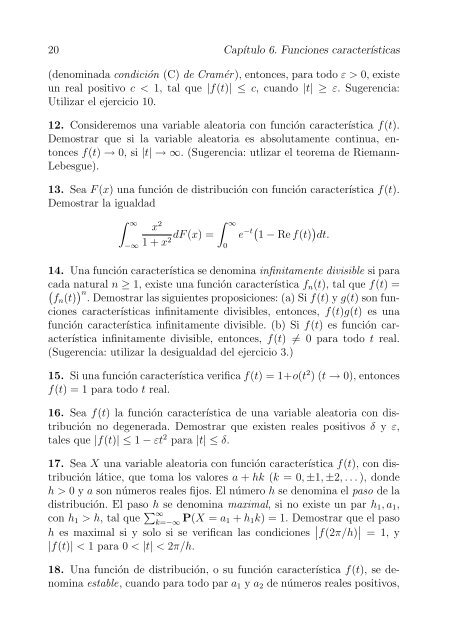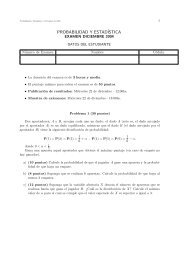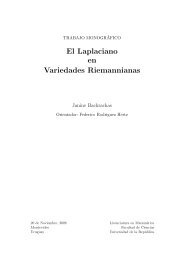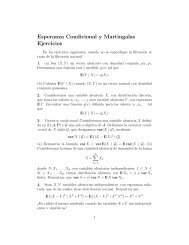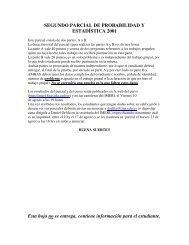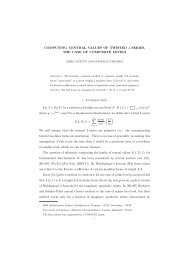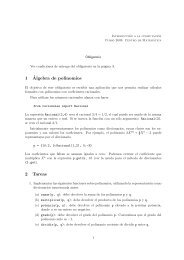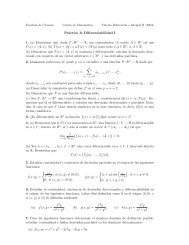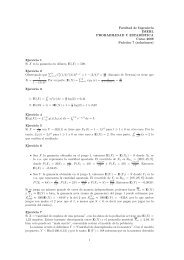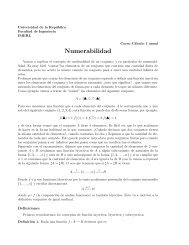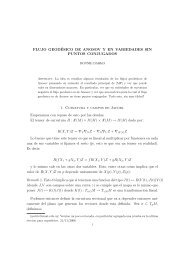CapÃtulos 6 y 7 de Petrov. V.V, Mordecki, E. TeorÃa de la ...
CapÃtulos 6 y 7 de Petrov. V.V, Mordecki, E. TeorÃa de la ...
CapÃtulos 6 y 7 de Petrov. V.V, Mordecki, E. TeorÃa de la ...
Create successful ePaper yourself
Turn your PDF publications into a flip-book with our unique Google optimized e-Paper software.
20 Capítulo 6. Funciones características(<strong>de</strong>nominada condición (C) <strong>de</strong> Cramér), entonces, para todo ε > 0, existeun real positivo c < 1, tal que |f(t)| ≤ c, cuando |t| ≥ ε. Sugerencia:Utilizar el ejercicio 10.12. Consi<strong>de</strong>remos una variable aleatoria con función característica f(t).Demostrar que si <strong>la</strong> variable aleatoria es absolutamente continua, entoncesf(t) → 0, si |t| → ∞. (Sugerencia: utlizar el teorema <strong>de</strong> Riemann-Lebesgue).13. Sea F (x) una función <strong>de</strong> distribución con función característica f(t).Demostrar <strong>la</strong> igualdad∫ ∞x 2 ∫ ∞−∞ 1 + x dF (x) = 2 0e −t( 1 − Re f(t) ) dt.14. Una función característica se <strong>de</strong>nomina infinitamente divisible si paracada natural n ≥ 1, existe una función característica f n (t), tal que f(t) =(fn (t) ) n. Demostrar <strong>la</strong>s siguientes proposiciones: (a) Si f(t) y g(t) son funcionescaracterísticas infinitamente divisibles, entonces, f(t)g(t) es unafunción característica infinitamente divisible. (b) Si f(t) es función característicainfinitamente divisible, entonces, f(t) ≠ 0 para todo t real.(Sugerencia: utilizar <strong>la</strong> <strong>de</strong>sigualdad <strong>de</strong>l ejercicio 3.)15. Si una función característica verifica f(t) = 1+o(t 2 ) (t → 0), entoncesf(t) = 1 para todo t real.16. Sea f(t) <strong>la</strong> función característica <strong>de</strong> una variable aleatoria con distribuciónno <strong>de</strong>generada. Demostrar que existen reales positivos δ y ε,tales que |f(t)| ≤ 1 − εt 2 para |t| ≤ δ.17. Sea X una variable aleatoria con función característica f(t), con distribuciónlátice, que toma los valores a + hk (k = 0, ±1, ±2, . . . ), don<strong>de</strong>h > 0 y a son números reales fijos. El número h se <strong>de</strong>nomina el paso <strong>de</strong> <strong>la</strong>distribución. El paso h se <strong>de</strong>nomina maximal, si no existe un par h 1 , a 1 ,con h 1 > h, tal que ∑ ∞k=−∞ P(X = a 1 + h 1 k) = 1. Demostrar que el pasoh es maximal si y solo si se verifican <strong>la</strong>s condiciones ∣ ∣ f(2π/h) = 1, y|f(t)| < 1 para 0 < |t| < 2π/h.18. Una función <strong>de</strong> distribución, o su función característica f(t), se <strong>de</strong>nominaestable, cuando para todo par a 1 y a 2 <strong>de</strong> números reales positivos,


